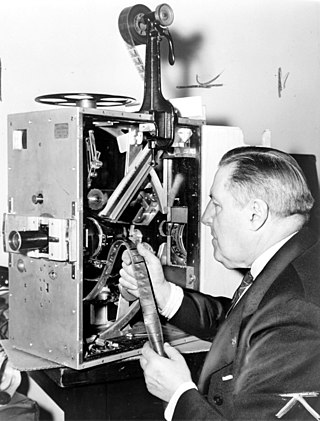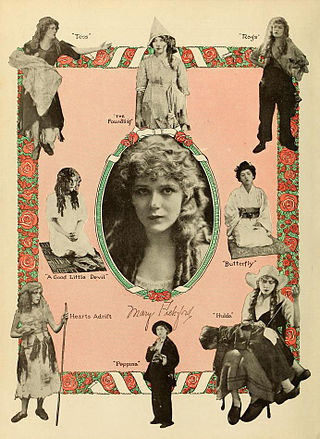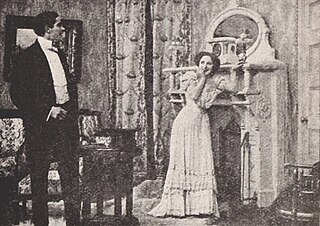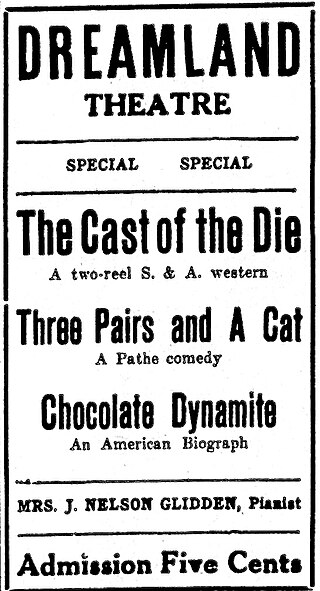Biograph Studios was an early film studio and laboratory complex, built in 1912 by the Biograph Company at 807 East 175th Street, in The Bronx, New York City, New York.
Biograph Studios was an early film studio and laboratory complex, built in 1912 by the Biograph Company at 807 East 175th Street, in The Bronx, New York City, New York.

The first studio of the Biograph Company, formerly American Mutoscope and Biograph Company, was located just south of Union Square on the roof of 841 Broadway at 13th Street in Manhattan, known then as the Hackett Carhart Building and today as the Roosevelt Building. The set-up was similar to Thomas Edison's "Black Maria" in West Orange, New Jersey, being mounted on circular tracks to be able to get the best possible sunlight. As of 1988, the foundations of this machinery were still extant. [1]
The company moved in 1906 to a brownstone a few blocks away at 11 East 14th Street, where it remained until 1913. The brownstone was torn down in the 1960s. It was at this location that D. W. Griffith began as a director, and quickly became the studio's focus. Griffith found and developed for the company stars such as Florence Lawrence, Blanche Sweet, Mary Pickford, the Gish sisters - Lillian and Dorothy, Lionel Barrymore, Henry B. Walthall, Mae Marsh, Mabel Normand, Harry Carey, Owen Moore, Robert Harron and director Mack Sennett. [1] Due to their overwhelming popularity and the fact that their names were not credited, stars like Florence Lawrence and Mary Pickford became known as the 'Biograph Girls,' before screen credits began to become the norm.
The company used Fort Lee extensively for location shooting. [2]

Griffith left Biograph in October 1913, [3] a few months after the company had begun moving its Manhattan operations to new, state-of-the-art facilities at 807 East 175th Street in The Bronx, another borough of New York City. [4] [5] Without Griffith, the studio did not prosper, and the company was dissolved in 1915, [1] and the studio property was leased out to other production companies after Biograph's production stopped. The studio facilities and laboratory were acquired by one of Biograph Company's creditors, the Empire Trust Company, although some of the Biograph old management continued to manage it. [6] [7] Herbert Yates acquired the Biograph Studio properties and Film laboratory facilities in 1928. Biograph Studio facilities in The Bronx were made a subsidiary of his Consolidated Film Industries. [8] [9]
Some advertising films and a few feature films were made at the studio in the 1930s, including Midnight (1934), Woman in the Dark (1934), The Crime of Dr. Crespi (1935), Manhattan Merry-Go-Round (1937), the Yiddish-language folk drama Tevya (1939), and the Oscar Micheaux production The Notorious Elinor Lee (1940).
However, the studio facilities principal activity in that decade was the production of shorts for Universal, Columbia, and RKO, mostly involving New York-based actors and entertainers. The studio suspended operations in 1939, due partly to curtailment of the activities of independent producers because of World War II and partly to a decline in the commercial film market, according to its general manager. At this time, the remaining Biograph films collection was donated to the film department of the Museum of Modern Art. [10] The Soundies Distributing Corporation filmed at the Biograph Studios in 1944. [11]
Empire Trust later assigned management of the property to one of its own subsidiaries, The Actinograph Corp., which held it until 1948. [12]
Martin Poll (who later became New York's Commissioner of Motion Picture Arts) restored the Biograph Studio facilities and reopened it in 1956 as the Gold Medal Studios. [13] [14] [15] Gold Medal Studios became the largest film studio in the United States outside of Los Angeles at the time of its 1956 reopening. [13] Poll sold the property in 1961, [16] when it was incorporated into a newer company unrelated to the original Biograph Company, using the name Biograph Studios, Inc. It opened in 1961. [17]
The television series Naked City , Car 54, Where Are You? , and East Side/West Side , and movies such as A Face in the Crowd , Odds Against Tomorrow , The Fugitive Kind, The Goddess , Pretty Boy Floyd, BUtterfield 8 , The Incident , and John and Mary were filmed there. The Biograph Studio facilities went dormant again in the 1970s. The studio facilities and laboratory burned down in 1980. [18]
The site is now occupied by a New York City Department of Sanitation garage.

David Wark Griffith was an American film director. Considered one of the most influential figures in the history of the motion picture, he pioneered many aspects of film editing and expanded the art of the narrative film.

Gladys Marie Smith, known professionally as Mary Pickford, was a Canadian actress resident in the U.S., and also producer, screenwriter and film studio founder, who was a pioneer in the US film industry with a Hollywood career that spanned five decades.

Gottfried Wilhelm Bitzer was an American cinematographer, notable for his close association and pioneering work with D. W. Griffith.

The Biograph Company, also known as the American Mutoscope and Biograph Company, was a motion picture company founded in 1895 and active until 1916. It was the first company in the United States devoted entirely to film production and exhibition, and for two decades was one of the most prolific, releasing over 3000 short films and 12 feature films. During the height of silent film as a medium, Biograph was the most prominent U.S. film studio and one of the most respected and influential studios worldwide, only rivaled by Germany's UFA, Sweden's Svensk Filmindustri and France's Pathé. The company was home to pioneering director D. W. Griffith and such actors as Mary Pickford, Lillian Gish, and Lionel Barrymore.

The Kalem Company was an early American film studio founded in New York City in 1907. It was one of the first companies to make films abroad and to set up winter production facilities, first in Florida and then in California. Kalem was sold to Vitagraph Studios in 1917.

Marion Leonard was an American stage actress who became one of the first motion picture celebrities in the early years of the silent film era.

Friends is a 1912 film written and directed by D. W. Griffith and starring Mary Pickford, Henry B. Walthall, Lionel Barrymore, and Harry Carey. Walthall and Barrymore portray two old friends who each wind up involved with a beautiful girl (Pickford) who lives above a mining camp saloon.

Mary Pickford (1892–1979) was a Canadian-American motion picture actress, producer, and writer. During the silent film era she became one of the first great celebrities of the cinema and a popular icon known to the public as "America's Sweetheart".

Ramona is a 1910 American short drama film directed by D. W. Griffith, based on Helen Hunt Jackson's 1884 novel Ramona. Through a love story, the early silent short explores racial injustice to Native Americans and stars Mary Pickford and Henry B. Walthall. A copy of the print survives in the Library of Congress film archive. The film was remade in 1928 with Dolores del Río and 1936 with Loretta Young.

Gladys Egan was an early 20th-century American child actress, who between 1907 and 1914 performed professionally in theatre productions as well as in scores of silent films. She began her brief entertainment career appearing on the New York stage as well as in plays presented across the country by traveling companies. By 1908 she also started working in the film industry, where for six years she acted almost exclusively in motion pictures for the Biograph Company of New York. The vast majority of her screen roles during that period were in shorts directed by D. W. Griffith, who cast her in over 90 of his releases. While most of Egan's films were produced by Biograph, she did work for other motion-picture companies between 1911 and 1914, such as the Reliance Film Company and Independent Moving Pictures. By 1916, Egan's acting career appears to have ended, and she no longer was being mentioned in major trade journals or included in published studio personnel directories as a regularly employed actor. Although she may have performed as an extra or in some bit parts after 1914, no available filmographies or entertainment publications from the period cite Egan in any screen or stage role after that year.

The Italian Barber is a 1911 short silent drama film directed by D. W. Griffith, starring Joseph Graybill and featuring Mary Pickford. The film, by the Biograph Company, was shot in Fort Lee, New Jersey when many early film studios in America's first motion picture industry were based there at the beginning of the 20th century.

The Maniac Cook is a 1909 American silent thriller film produced by the Biograph Company of New York, directed by D. W. Griffith, and starring Anita Hendrie in the title role. Principal cast members also include Harry Solter and Marion Leonard.

Edgar Allen Poe [sic] is a 1909 American silent drama film produced by the Biograph Company of New York and directed and co-written by D. W. Griffith. Herbert Yost stars in this short as the 19th-century American writer and poet Edgar Allan Poe, while Linda Arvidson portrays Poe's wife Virginia. When it was released in February 1909 and throughout its theatrical run, the film was consistently identified and advertised with Poe's middle name misspelled in its official title, using an "e" instead of the correct second "a". The short was also originally shipped to theaters on a "split reel", which was a single reel that accommodated more than one film. This 450-foot drama shared its reel with another Biograph short, the 558-foot comedy A Wreath in Time. Prints of both films survive.
The Little Darling is a 1909 comedy short produced by the Biograph Company of New York and directed by D. W. Griffith. It was released to theaters on a split-reel with Griffith's eleven-minute drama The Sealed Room. The production was filmed in two days–July 27 and August 3, 1909–and at two locations: on interior sets in Biograph's Manhattan studio at 11 East 14th Street and on location at Cuddebackville, New York.

Trying to Get Arrested is a 1909 American comedy short film directed by D. W. Griffith, produced by the Biograph Company of New York City, and starring John R. Cumpson. Filmed in two days in early 1909 at Palisades Park, New Jersey, it was released in April that year and distributed to theaters on a "split reel", which was a single film reel that included more than one motion picture. The other picture that accompanied this comedy was the Biograph "dramedy" The Road to the Heart.

A Rude Hostess is a 1909 American silent film comedy written and directed by D. W. Griffith, produced by the American Mutoscope and Biograph Company in New York City, and co-starring Marion Leonard and Arthur V. Johnson. At its release in April 1909, the short was distributed to theaters on a "split reel", which was a single reel that accommodated more than one film. A Rude Hostess shared its reel with another Biograph comedy short directed by Griffith, Schneider's Anti-Noise Crusade. Original contact-print paper rolls of both motion pictures, as well as projectable safety-stock copies of the films, are preserved in the Library of Congress.

Schneider's Anti-Noise Crusade is a 1909 American silent film comedy written and directed by D. W. Griffith, produced by the American Mutoscope and Biograph Company in New York City, and co-starring John R. Cumpson and Florence Lawrence. At its release in April 1909, the short was distributed to theaters on a "split reel", which was a single reel that accommodated more than one film. This short shared its reel with another Biograph comedy directed by Griffith, A Rude Hostess.

The Medicine Bottle is a 1909 American silent thriller film written and directed by D. W. Griffith, produced by the American Mutoscope and Biograph Company in New York City, and starring Florence Lawrence, Adele DeGarde, and Marion Leonard. At its release in March 1909, the short was distributed to theaters on a "split reel", which was a single projection reel that accommodated more than one film. This drama shared its reel with another Biograph short directed by Griffith, the comedy Jones and His New Neighbors.

The Invisible Fluid is a 1908 American silent science fiction comedy film produced by the American Mutoscope and Biograph Company of New York, directed by Wallace McCutcheon Sr., and starring Edward Dillon. The short's plot relies extensively on the filming and editing technique of substitution splicing, also known as "stop trick", a special effect that creates the illusion of various characters or objects suddenly vanishing on screen.

Chocolate Dynamite is a lost 1914 American silent comedy film produced by the Biograph Company and, according to some modern references, directed by either Lionel Barrymore or Edward Dillon. Little is known about many aspects of this short, which had an approximate running time between six and seven minutes. No Biograph studio records have been found that conclusively identify its director or mention by name a single actor in the production. Records do, however, document that the motion picture was based on "Captured by Dynamite", a short story written by Helen Combes. They also document that the comedy was filmed in New York City and was actually completed in late August 1913, a full six months before the company officially released it to theaters. During the picture's initial distribution in the United States, it was shipped on a "split reel", a term used in the silent era to describe a reel that held more than one motion picture. The film reel for Chocolate Dynamite also included Because of a Hat, another Biograph comedy short.
Notes
Further reading